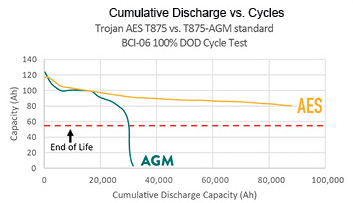Battery advances
Equipment powered by premium AGM (AES) batteries delivers increased cycle life and performance.
by Matt Herr, Trojan senior product manager for motive.
In the United States, the Inflation Reduction Act, corporate and governmental environmental regulations and the desire to reduce noise and vibration levels are fueling the demand for battery-powered rental equipment.
 |
| After a brief break-in stage (30-50 cycles), The Trojan AES Battery maintains higher capacity levels than standard AGM for the rest of its life. |
Further, the success of battery-powered access, material handling and floorcare equipment dispels the myth of the superiority of gasoline and diesel equipment.
As equipment renters struggle with labor shortages, rising wages and supply chain issues, they expect affordable problem-solving battery technology that expands the limits of standard AGM technology while increasing battery life and cutting downtime and costs.
A few battery manufacturers, offer a new premium AGM battery with carbon additives that deliver the solution.
The maintenance-free battery dramatically increases cycle life and can escalate productivity in:
- Floorcare machines
- Material handling equipment
- Access Equipment
- Golf carts, personal transportation vehicles (PTVs) and utility vehicles
- Renewable energy
Standard AGM vs. Premium AGM Technology: What’s the Difference?
Standard AGM batteries need recharging after each use to meet their stated cycle life. They should not be operated at a depth of discharge below 60 percent in most applications because they experience harm and possibly early failure when used in a partial state of charge (PSoC). Yet that frequently happens due to the demands of busy worksites. This reduces the battery’s cycle life and increases the frequency of replacements.
Premium AGM batteries with carbon additives, on the other hand, overcome this issue. They are designed to work in PSoC, preventing corrosion and sulfation and preserving the negative active material.
The best of these batteries last three to five years, charge up to 30 percent faster than a standard AGM battery and are designed for opportunity charging. The performance and longevity of these batteries differ by manufacturer.
What to look for and what to avoid in premium AGM batteries
Look for a premium AGM (AES) battery with a combination of advanced technologies that optimize the negative active material and also prevent the degradation of the positive material. Most only prevent degradation of the negative active material and have fewer charge cycles than those that do both.
You’ll also want to know how many charge cycles the battery gets. The best of these models delivers up to 3x the cycle life of a standard AGM and is validated at 1,200 cycles at 100 percent depth of discharge (DoD). Most premium AGM batteries only double the cycle life.
Does it perform well in extremely hot or cold climates? If this is an issue for you, look for a battery that delivers robust performance in temperatures ranging from -40F to 160F. That means fewer work stoppages and higher productivity.
Has the battery been tested to repeatedly withstand long-term PSoC to ensure optimal performance?
Is the battery designed and manufactured to absorb the vibrations and shock of the most demanding construction sites, and how long is the warranty? These factors can indicate the quality of the battery.
How is it charged? If you don’t want to buy a new charger, look for a battery with plug-and-play compatibility with chargers using AGM profiles.
Cuts costs and boosts productivity
Both you and your customers know the benefits and limitations of standard AGM batteries. Although sealed and maintenance-free, they experience corrosion, sulfation and possibly early failure if repeatedly used in PSoC, can’t withstand extreme temperatures and are not designed for opportunity charging.
Depending on the manufacturer, new premium AGM batteries with carbon additives virtually eliminate those performance barriers. They are designed for PSoC operation, opportunity charging and to withstand extreme temperatures. This boosts longevity while cutting downtime, labor costs and replacements.
These reasonably priced batteries let you maintain your customer base, attract new clients, and help increase revenues.
Learn more about Trojan’s AES Battery or find your local Trojan Dealer or Distributor.








